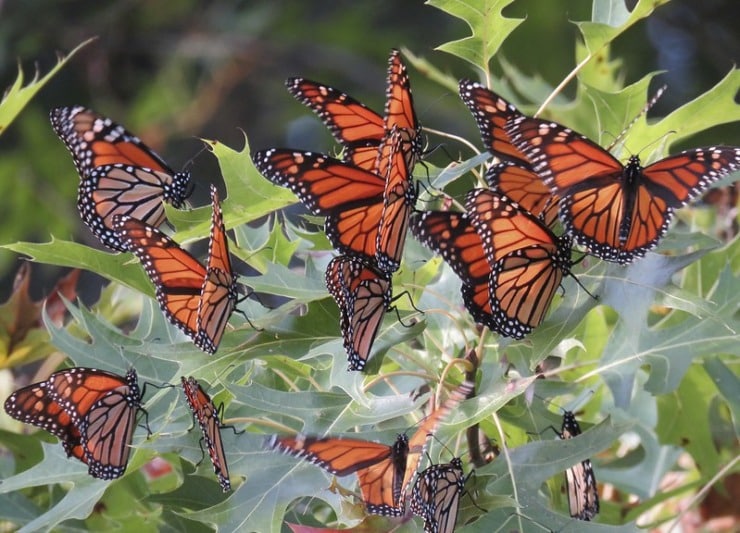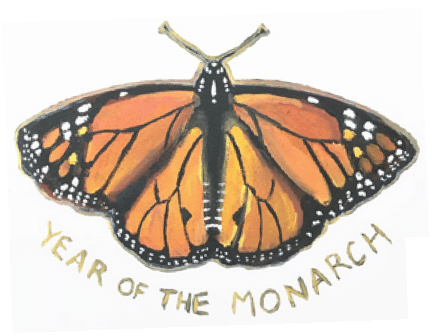At one point during this Year of the Monarch, it occurred to me that I was in a new relationship—one that seemed to track the trope-iest of tropes: the romantic comedy. (Stick with me.)
Fifteen years ago, a local venue hosted a temporary exhibition of a Butterfly Garden—but somehow my mind only registered “Garden.” Lovely! I thought, anticipating swathes of native grasses and wildflowers.
We visitors stood in a long line and were admitted only ten at a time into a large screened area. Why the screen? I wondered.
Entering the space, I had my answer. Indeed, there was far more emphasis on “Butterfly” than “Garden,” and winged insects gleamed blue and yellow and orange and black as they flitted around us. My fellow visitors, being, well, normal, stuck out arms and fingers, hoping for a landing—a butterfly kiss, so to speak.
I, on the other hand, ducked and dodged like a crazy person. (Is it on me? I think it’s on me. Yuck! Shoo!)
Revealing Rom-com Back Story? Check.
Quirky Rom-com Heroine? Check.
Fast-forward to the 2020s: a friend showed up at our door with a bright green chrysalis so that we could observe the monarch butterfly’s metamorphosis.
My entomophobia flared. Was I really going to let an insect pupate in my house?
Though wary at first, I grew gradually more intrigued by the monarch, learning about its history and habits, its multi-generational migration, its amazing mechanisms and back-up mechanisms for navigation. Despite myself, I peeked at it over and over again, wondering about its progress.
Fateful Rom-com “Meet-Cute”? Check.
Elusive Rom-com Hero? Check.
And thus, with the necessary pieces of a romantic comedy in place, my love story unfolded.
Listen to Dheepa Maturi read the story
My Feelings Grow
I returned home one day to find the monarch gone—it had hatched in my absence, and my husband and son had ushered it out into the world.
My disappointment at missing its departure surprised me, and in the days that followed, the monarch continued to flit through my consciousness. I imagined it flying free, navigating by way of the sun, making its journey along an ancestral path millions of years old. With the destruction of its habitat, would it find enough milkweed to eat along the way? With the ravages of climate change, would its overwintering grounds still be there when it arrived? I felt more concern than I ever imagined I would.
And I began to see reminders of my missing friend everywhere. On a Zoom call, one participant’s profile photo showed a monarch fluttering in a doorway. When I installed a digital screen at home, the first stock photo was, you guessed it, a kaleidoscope of monarchs. (How I love that a group of monarch butterflies is called a kaleidoscope!)
I saw monarchs sprawled in giant 3D art across a mall atrium, and shaped into benches, and emblazoned on greeting cards and books and bookmarks. One day, I looked down at a bank teller’s fingernails and my eyes widened—they’d been intricately painted with ochre and black lines to mimic a monarch’s wings!
My husband, a researcher, suggested that selection bias might be the reason for my sightings, but I figured he was jealous.
A Full-blown Romance
Sadly, all of these monarch sightings were artistic and digital, but not actual. But I began to seek out real-life encounters, and they even became part of my travel plans. At Natural Bridges State Park in Santa Cruz, California, as well as the Monarch Grove Sanctuary in Pacific Grove, I saw real kaleidoscopes of monarchs, gleaming and shimmering together on trees. How beautiful they looked, and how fragile.
Later, when I traveled to Austin, Texas to visit my friend N., she was amenable to—and even enthusiastic about—my monarch mission. At the Lady Bird Johnson Wildflower Center, we saw monarch butterflies—four, five, six, more—flitting about in the warm November weather. Suddenly, I realized that I was traveling along a migration route—perhaps these monarchs had also started their journey in Indiana and were now at a Texas waystation before overwintering in Mexico.
As I continued to search and find monarchs, the thought struck me. My initial aversion, my revulsion and repulsion, had transformed, slowly and surely, into delight. Lo and behold . . . .
The Moment of Realization
. . . . I truly loved this little creature.
Over time, my attention and focus on one living, breathing being had made my perceptions change. Welcoming it into my consciousness, into my life, even into my travel plans, had made it something I valued, something I even loved.
I had to wonder—how many of my (numerous) aversions only needed tending, contemplation, and consciousness to transform into something more positive? How many “romances” had I missed by ignoring the creatures of the world, by looking the other way?
And how many love stories could I still experience by directing my attention more widely, more deeply? I began to understand that all of my love stories actually begin with me.
Happily Ever After.
I returned to Austin last month, amazed yet again by the plentiful and multi-colored Texas wildflowers and all the pollinator insects blissing about within them.
And then, I surprised myself. I can’t say I would have done this with any other insect (it’s a journey, friends), but when I saw the monarchs—four, five, six, more—I held out a hand, hoping for a butterfly kiss.
Join the romance!
In these last few months of the Year of the Monarch, there are still lots of fun ways to participate:
Add your Lines to our Community Poem!
Thank you to those who have already contributed lines to our crowd-sourced poem, “Dear Seed,” intended to inspire the planting of milkweed, the monarch butterfly’s sole (and depleting) habitat. As an example, this is my contribution:
Dear Seed,
let your boundaries dissolve,
and welcome soil, water, light—
welcome Earth, welcome life.
You can add your own lines to the comment box below. If you prefer, feel free to begin your lines with “Dear Caterpillar” or “Dear Monarch Butterfly,” instead of “Dear Seed.”
All of our lines will be woven together by a Tweetspeak poet, to represent the way in which we are also weaving together our attention, our intention, our energy, and our commitment on behalf of the magnificent monarch!
Time to (Garden) Party!
Watch for an invitation to a (virtual) garden party this fall, the culmination of the Year of the Monarch! We will share our experiences—both positive and negative—and Tweetspeak’s managing editor L. L. Barkat has a few surprises in store!
Plant Milkweed and Send us Photos
Consider planting milkweed in your own yard. (And if you’re a non-gardener like me, take heart from my gardening snafus!)
If you’ve already planted your milkweed, send photos to show us your progress, and we will post them.
Drop us a note!
Tell us about your own butterfly romance. In this instance, it’s okay to kiss and tell!
Photo by USFWS Midwest Region, Creative Commons License via Flickr. Post by Dheepa R. Maturi.
- Morphing: Lessons from the Year of the Monarch - October 23, 2024
- Year of the Monarch: Butterfly Kisses—A Romantic Comedy - August 7, 2024
- Year of the Monarch: In Sync — a Communal Poem for the Monarch Butterfly - April 11, 2024


L.L. Barkat says
This totally made me laugh: “My husband, a researcher, suggested that selection bias might be the reason for my sightings, but I figured he was jealous.” Indeed.
And this gave me lovely pause… “all of my love stories actually begin with me.”
Thanks for the entertaining and tender chronicle of your *own* monarch journey, Dheepa. Little did you know you were on board for a romance! 😉 .
Dheepa Maturi says
Thank you so much, Laura—it was so much fun to write (and record)! You are so right about the unexpected inspirations that arise from deep and long-term engagement with a topic!
Arti Parikh Roy says
Dheepa, I am so grateful for our connection and how you continue to open my eyes to the world around me. I have a similar relationship with my butterflies and now cicadas!!! Growing up with cicadas all over Indiana, I am finally at a place where I can truly celebrate them. Every piece of nature I see has become so metaphorical and I continue to adore how you put words to my observations!! 💗🥳
Dheepa R. Maturi says
Arti, I admire your ability to engage to positively with cicadas! I am working my way up (down?) from butterflies! In all seriousness, though, you’re absolutely right — cicada music is absolutely synonymous with a midwestern summer!
Megan Willome says
I love the Lady Bird Wildflower Center! And I recently used their online, public database to identify wildflowers for a poem-painting collaboration.
Most of all I am glad your romance with the monarch has had a happy ending. It is, indeed, fun, to be on their migratory pattern.
Dheepa R. Maturi says
That’s right–you are a Texan! Even though I lived in Texas for two years, I never saw the wildflowers back then. The varieties and colors are truly amazing! Thank you so much for reading–very much appreciated!